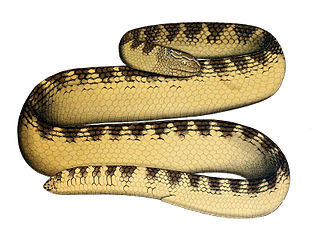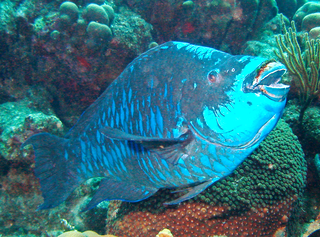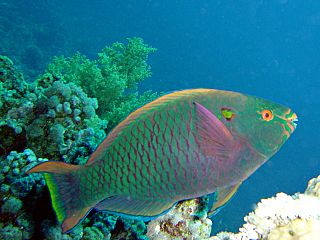
A coral reef is an underwater ecosystem characterized by reef-building corals. Reefs are formed of colonies of coral polyps held together by calcium carbonate. Most coral reefs are built from stony corals, whose polyps cluster in groups.

The green humphead parrotfish is the largest species of parrotfish, growing to lengths of 1.5 m (4.9 ft) and weighing up to 75 kg (165 lb).

Aipysurus eydouxii, commonly known as the beaded sea snake, marbled seasnake, or spine-tailed seasnake, is a species of sea snake in the family Elapidae. This species of snake is unusual amongst sea snakes in that it feeds exclusively on fish eggs. As part of this unusual diet, this species has lost its fangs, and the venom glands are almost entirely atrophied.

Sea snakes, or coral reef snakes, are a subfamily of elapid snakes, the Hydrophiinae, that inhabit marine environments for most or all of their lives. Most are venomous, except the genus Emydocephalus, which feeds almost exclusively on fish eggs. Sea snakes are extensively adapted to a fully aquatic life and are unable to move on land, except for the genus Laticauda, which has limited land movement. They are found in warm coastal waters from the Indian Ocean to the Pacific and are closely related to venomous terrestrial snakes in Australia.
Rugosity, fr, is a measure of small-scale variations of amplitude in the height of a surface,

Ambush predators or sit-and-wait predators are carnivorous animals that capture or trap prey by stealth, luring or by strategies utilizing an element of surprise. Unlike pursuit predators, who chase to capture prey using sheer speed or endurance, ambush predators avoid fatigue by staying in concealment, waiting patiently for the prey to get near, before launching a sudden overwhelming attack that quickly incapacitates and captures the prey.

Sea kraits are a genus of venomous elapid sea snakes, Laticauda. They are semiaquatic, and retain the wide ventral scales typical of terrestrial snakes for moving on land, but also have paddle-shaped tails for swimming. Sea kraits are often confused with another group of aquatic reptiles, the sea snakes. However, unlike the fully aquatic ovoviviparous sea snakes, sea kraits are oviparous and must come to land to digest prey and lay eggs. They also have independent evolutionary origins into aquatic habitats, with sea kraits diverging earlier from other Australasian elapids. Thus, sea kraits and sea snakes are an example of convergent evolution into aquatic habitats within the Hydrophiinae snakes. Sea kraits are also often confused with land kraits , which are not aquatic.

The scissortail sergeant or striptailed damselfish is a large damselfish. It earns its name from the black-striped tail and sides, which are reminiscent of the insignia of a military Sergeant, being similar to those of the sergeant major damselfish. It grows to a length of about 16 centimetres (6.3 in).

The midnight parrotfish is a species of parrotfish that inhabits coral reefs mainly in the Caribbean, Bahamas, and Florida.

The stoplight parrotfish is a species of marine ray-finned fish, a parrotfish from the family Scaridae, inhabiting coral reefs in Florida, Caribbean Sea, Gulf of Mexico, Bermuda and as far south as Brazil. It mainly feeds on algae by scraping and excavating it with its teeth. Like most of its relatives, it is able to change sex.

Dascyllus albisella commonly known as the Hawaiian dascyllus, Hawaiian domino, Domino damselfish, or white-spotted damsel is a marine fish found in the Eastern Central Pacific.

Neoglyphidodon melas is a damselfish from the Indo-West Pacific. It often makes its way into the aquarium trade. It grows to a size of 18 cm (7.1 in) in length.

Coral reef fish are fish which live amongst or in close relation to coral reefs. Coral reefs form complex ecosystems with tremendous biodiversity. Among the myriad inhabitants, the fish stand out as colourful and interesting to watch. Hundreds of species can exist in a small area of a healthy reef, many of them hidden or well camouflaged. Reef fish have developed many ingenious specialisations adapted to survival on the reefs.
Aipysurus duboisii, also known as the Dubois' sea snake or reef shallows sea snake, is a species of venomous sea snake. Its geographic range includes Papua New Guinea, New Caledonia and the northern, eastern and western coastal areas of Australia, that is the Coral Sea, Arafura Sea, Timor Sea and Indian Ocean. They live at depths up to 80 meters in coral reef flats, sandy and silty sediments which contain seaweed, invertebrates and corals or sponges that can serve as shelter. These snakes feed on moray eels and various fish that live on the seafloor, up to 110 cm in size. They are viviparous, giving birth to live young rather than laying eggs. They have medium aggressiveness, i.e., will bite if provoked, but not spontaneously. The fangs are 1.8 mm long, which are relatively short for a snake, and the venom yield is 0.43 mg. Aipysurus duboisii is a crepuscular species, meaning that they are most active at dawn and dusk.
Emydocephalus is a genus of sea snakes, also known as turtle-headed sea snakes, in the family Elapidae. Unlike most sea snakes, all species of Emydocephalus, have an absence of teeth on their dentary and palatine bones, and lack venom. The dentary and palantine bones bear only a row of papillae. Emydocephalus does, however, bear fangs and many small pterygoid teeth. This reduced dentition is due to their diet consisting almost entirely of fish eggs.

Sexual selection in scaled reptiles studies how sexual selection manifests in snakes and lizards, which constitute the order Squamata of reptiles. Each of the over three thousand snakes use different tactics in acquiring mates. Ritual combat between males for the females they want to mate with includes topping, a behavior exhibited by most viperids in which one male will twist around the vertically elevated fore body of its opponent and forcing it downward. It is common for neck biting to occur while the snakes are entwined.

Scarus niger, common names the swarthy parrotfish, dusky parrotfish, and black parrotfish, is a species of parrotfish. It is in the phylum Chordata, class Actinopterygii, and family Scaridae. Like other members of its family, is has characteristic 10 dorsal soft rays, 9 dorsal spines, 9 anal soft rays, and 3 anal spines, It is found in Indo-West and Central Pacific, from the Red Sea, north to Japan, south to Australia and east to French Polynesia. It is found in lagoons, channels and outer reefs slopes on the depths of 2 to 20 metres. The dusky parrotfish often lives in solitude, but males may also live in a small group of mating females. The dusky parrotfish is primarily herbivorous, and its main source of food is benthic algae. At maturity, the fish is approximately 230-240mm long and weighs around 240g.

A corallivore is an animal that feeds on coral. Corallivores are an important group of reef organism because they can influence coral abundance, distribution, and community structure. Corallivores feed on coral using a variety of unique adaptations and strategies. Animals known to be corallivores include certain mollusks, annelids, fish, crustaceans, flatworms and echinoderms. The first recorded evidence of corallivory was presented by Charles Darwin in 1842 during his voyage on HMS Beagle in which he found coral in the stomach of two Scarus parrotfish.

The lagoon damselfish, also known as the sweetlip damsel, is a species of ray-finned fish, a damselfish from the family Pomacentridae. It is a larger species of damselfish which is found in the Indo-Pacific where it occurs around branching corals in sheltered areas of reefs.
Emydocephalus orarius, also known as the white-crowned snake or white-naped snake, is a species of venomous elapid sea snake endemic to Australian waters. The specific epithet orarius (“coastal”) refers to its known habitat.

















